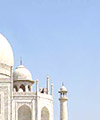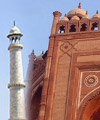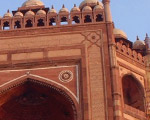|
Jhansi
The gateway to Bundelkhand, Jhansi is a city that is linked still
with the legend of its fiery queen, Rani Laxmibai.
In the 1857 war against the British, she led her troops into battle,
striking a blow for Indian independence and laying her life down
for her cause. Jhansi is ideally located for various rewarding excursions
in the area.
Jhansi was a stronghold of the Chandela kings. Balwant Nagar was
the name of this place. But in 11th. century Jhansi lost its importance.
In 17th. century under Raja Bir Singh Deo of Orchha Jhansi again
rose to prominence. Raja Bir Singh Deo had good relations with the
mughal emperor Jehangir. In 1613 Raja Bir Singh Deo constructed
the Jhansi fort. He died in 1627. After his death his son Juhar
Singh succeeded him.
Maharaja Chattrasal Bundela of Panna was a good administrator and
a brave warrior. In 1729 Mohammed Khan Bangash attacked Chattrasal.
Peshwa Baji Rao(I ) helped Maharaja Chattrasal and defeated mughal
army. As a mark of gratitude Maharaja Chattrasal offered a part
of his state to Maratha Peshwa Baji Rao(I). Jhansi was also included
in this part.
In 1742 Naroshanker was made the subedar of Jhansi. During his
tenure of 15 years he not only extended the Jhansi fort which was
of strategic importance but also constructed some other buildings.
The extended part of the fort is called Shankergarh. In 1757 Naroshanker
was called back by the Peshwa. After him Madhav Govind Kakirde and
then Babulal Kanahai were made the subedars of Jhansi.
In 1766 Vishwas Rao Laxman was made the subedar of Jhansi. His
period was from 1766 to 1769. After him Raghunath Rao (II) Newalkar
was appointed the subedar of Jhansi. He was a very able administrator.
He increased the revenue of the state. The MahaLakshmi Temple and
the Raghunath Temple were built by him. For his own residence he
constructed a beautiful building Rani Mahal in the city. In 1796
Raghunath Rao passed the subedari in favour of his brother Shiv
Rao Hari.
Excursion
Baruasagar
Baruasagar named after a large lake called Baruasagar Tal. This
lake was created about 260 years ago when Raja Udit Singh of Orcha
erected and embankment. A fort was built by him. The ruins of two
old Chandela Temples, made of granite, are on the north-east of
the lake. The older one is called Ghughua Math. Nearby is the later
Gupta period temple called Jarai-Ka-Math. This is dedicated to Lord
Shiva and Devi Parvati.
Paricha Dam
Paricha Dam is built on the river Betwa. Its reservoir - a placid
stretch of water that runs to Notghat Bridge which is 34 Km. away.
This is an ideal place not only for water sports but also for adventure
seekers and picnickers. The whole area is rich in scenic beauty
and holds the promise of an unforgettable holiday.
Todi Fathepur
The Todi Fathepur fort is built on a hillock. It covers an area
of 5 acres and is surrounded by three massive stone walls. This
fort is divided into four major parts known as Gusain Mahal, Ranwas,
Rajgarh Palace and the Rang Mahal Palace.
Samthar
Samthar which was formerly know as Samshergarh. Samthar was an independent
principality under the great Gujar warriors. The independent state
of Samthar was created by Chandrabhan Bar Gujar and his grand son
Madan singh, Governors of the state of Datia.
Orcha
Orcha, one of the ancient city situated on the bank of Betwa. This
place is famous for Raja Ram Temple and various other historical
monuments. Orcha was founded in 16th Century by the Bundela Chieftain,
Rudra Pratap Singh.
The main historical are the Jehangir Mahal, Raj Mahal, Rai Praveen
Mahal, Laxmi Narayan Temple and the Chaturbhuj Temple.
Datia
Datia, an ancient town, mention in the Mahabharat as "Daityavakra".
It is a pilgrimage spot for devotees of Siddhapeeth Shri Peetambra
Devi. The other places of interest are seven-storied palace of Raja
Bir singh Ju Deo built atop a hill and the Gopeshwar Temple.
Shivpuri
Shivpuri, the summer capital of the scindia rulers of Gwalior. It
is famous for its forests, wild animals and natural surroundings.
The place of interest are the Madhav National Park, Madhav Vilas
Palace , George Castle and the Bhadaiya Kund.
Sonagiri
Sonagiri, the sacred Jain hill. There are about 77 Jain temples
build along the hills and its slopes. Among these the most beautiful
is the one which is dedicated to Chatranatha, the 8th of the 24
Tirthankaras.
Khajuraho
Khajuraho temples are a rare gift to the world. These temples were
erected in a span of 100 years from 950 AD to 1050 AD these temples
were constructed under Chandel Rajput.
The Kandariya Mahadev Temple is one of the most beautiful temple.
It is 116 feet high having largest number of sculptures of alluring
beauty. The other important temples are the Chausath Yogini Temple,
Matangeshwar Temple, Varaha Temple, Vamana Temple, Adinath Temple,
Chaturbhuj and Duladeo Temples.
Top
Getting There
By Road
Jhansi is situated on National Highways No. 25 and 26 and is well
connected with the entire country.
By Air
Nearest airports are Gwalior - 103 km .and Khajuraho - 175 km.
By Rail
A junction along the Mumbai (Bombay) - Delhi route on Central Railway,
Jhansi is well linked by rail.
Top
General Information & Accomdation info on Jhansi city of Uttar Pradesh - India
|






